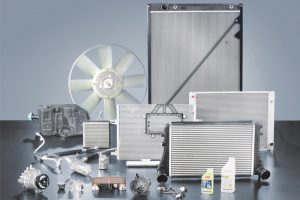Thermal management specialist, Behr Hella Service, explains how compressors are already changing to meet the needs of hybrid and electric vehicles.

While petrol and diesel will still dominate the car parc for a good few years yet, alternatively fuelled vehicles (AFVs) aren’t only the future; they’re also an important market today. For motor factors, this means stocking extra parts designed specifically for AFVs, such as the new generation of electrically-driven compressors.
To meet this demand, Behr Hella Service, developer of vehicle air conditioning and engine-cooling systems, last year signed an exclusive European distribution agreement with Sanden, which reportedly produced the first compressor for pure electric vehicles back in 1990.
As vehicle manufacturers bring out more hybrid and electric models, the industry will increasingly shift away from mechanically driven compressors to embrace the electric technology that Sanden pioneered.
Standard on traditional internal combustion engine vehicles, belt-driven compressors are also commonly used in start-stop equipped models, sometimes called micro-hybrids. The issue is that, when the vehicle is stationary and the engine is switched off, the compressor is not driven. After just two seconds, the temperature at the evaporator outlet begins to increase and the efficiency of the air conditioning system drops, although a storage evaporator can reduce the effect if the vehicle is not at a stop for more than a minute or so.
A similar challenge arises for full hybrids when the conventional fuel engine is switched off. Sanden’s high voltage electrical compressors solve the problem as they run continuously, although drawing only the minimum battery power necessary, therefore enabling the climate control functions to operate normally.
Steve Hudson from Behr Hella Service explained, “Most workshops are still finding their way when it comes to servicing and repairing hybrid and electric vehicles, and the compressor example here highlights some of the complications in the specific area of air conditioning.
“Another challenge with full hybrids is to ensure the temperature of the battery remains within its optimum operating temperature. Its service life decreases above 40°C, whereas efficiency and power output drops below -10°C. The VMs have chosen various solutions for this issue, from utilising cool air drawn in from the interior of the vehicle to adopting a secondary thermal circuit, which maintains a temperature between 15 and 30°C.
“Factors with an awareness of the issues can instil confidence in their workshop customers, even more so when they can introduce them to brands they can trust to provide the solutions they need.
“With Sanden units fitted to more than 25% of the world’s air conditioned vehicles, Behr Hella Service is able to supply a quality aftermarket solution with real original equipment pedigree. The range already covers popular models such as the Mercedes Benz B-Class and S400 Hybrid, as well as the Volvo V60 Hybrid and FH16 truck, and new part numbers are being added all the time.”








